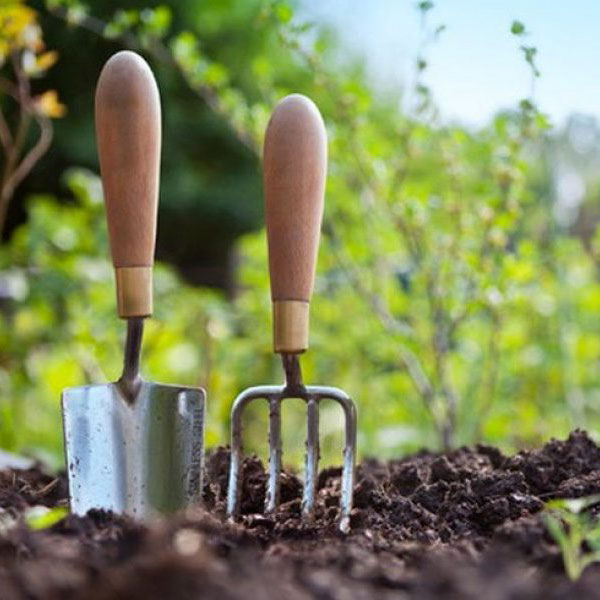Sow
You need to buy special ‘seed’ potatoes (also called tubers), these are just like potatoes you would buy from the supermarket, but will be certified virus-free. Buy seed potatoes from late winter onwards.
Grow
Once planted, when the stems are about 23cm (9in) high, start earthing up by carefully drawing soil up to the stems and covering to produce a flat-topped ridge about 15cm (6in) high. This can be done little and often or in one go.
Earthing up protects newly emerging foliage from to frost damage . It also protects developing new potatoes from light. Light turns tubers green and green potatoes are poisonous.
Keep crops well watered in dry weather; the vital time is once the tubers start to form. A liquid feed of a balanced general fertiliser every fortnight can help increase yields.
Plant
It’s vital with earlies and a good idea with maincrops to chit the seed potatoes first before planting; this means allowing them to start sprouting shoots. Stand them rose end up (the rose end is the one with the most small dents in the skin, or ‘eyes’) in egg boxes or similar in a light, frost-free place. The potatoes are ready to plant when the shoots are about 3cm (1in) long.
Follow these guidelines for planting times of seed tubers:
First earlies: around late March
Second earlies: early to mid-April
Maincrops: mid- to late April
This varies slightly depending on where you are in the country. If you are planting in containers, start even earlier.
The traditional way is to dig a narrow trench 12cm (5in) deep. This can be lined with compost or even grass clippings for a better crop. The seed tubers are spaced 30cm (12in) apart for earlies and 37cm (15in) for maincrop varieties in rows 24in (60cm) apart for earlies and 75cm (30in) apart for maincrop.
Potatoes need a sunny site away from frost pockets – the newly emerging foliage is susceptible to frost damage.
The other method is to grow the potatoes under black polythene. The tubers are planted through the black polythene. The advantage of this method is that there is no need to earth up and the new potatoes form just below soil level which means there’s no digging to harvest them.
Small crops of potatoes can also be grown in large, deep containers, and this is a good way of getting an early batch of new potatoes. Line the bottom 15cm (6in) of the container with potting compost and plant the seed potato just below this. As the new stems start growing, keep adding compost until the container is full.
Common problems
Potato blight
Potato blight: This is a common disease in wet, warm summers. The initial symptoms are a rapidly spreading brown watery rot, affecting leaves, and stems. Tubers can be affected too, and have a reddish-brown decay below the skin, firm at first but soon developing into a soft rot.
Remedy: Unfortunately once blight starts, it is very difficult to stop. You can remove blight-affected leaves, but removing too many leaves will damage the plant’s ability to grow. Earthing up potatoes provides some protection to tubers. There is no chemical control to stop blight, but you can spray with a protectant spray in June if it looks like it will be a wet one.
Potato blackleg
Potato blackleg: Potato blackleg is a common bacterial disease which causes black rotting at the stem base. Initial infections cause stunted growth and yellowing stems. If tubers form, the flesh may be grey or brown and rotten.
Remedy: Remove and destroy infected plants. Rotate crops. Buy resistant varieties such as ‘Charlotte’, ‘Pixie’ and ‘Saxon’.
Potato scab
Potato scab: This disease causes raised scab-like lesions on the potato surface. It does not affect the taste of the potato, and is easily removed on peeling.
Remedy: There is no control for scab, and you usually won’t know anything is wrong until harvest time. Scab can be worse in dry weather, so keep potatoes well watered. Don’t store any potatoes with scab.
Potato rot: Potato tuber rots are a frequent cause of losses prior to, or after, lifting. Significant problems often follow a wet growing season, particularly if the tubers are then lifted from wet soil.
Remedy: Use good quality, resistant certified seed tubers when planting and harvest when the soil is neither wet nor very hard and dry. Store in cool, dry conditions.
Harvesting
First early potatoes should be ready to lift in June and July, second earlies in July and August, maincrops from late August through October.
With earlies wait until the flowers open or the buds drop; the tubers are ready to harvest when they are the size of hens’ eggs.
With maincrops for storage wait, until the foliage turns yellow, then cut it and remove it. Leave for 10 days before harvesting the tubers, leaving them to dry for a few hours before storing.

